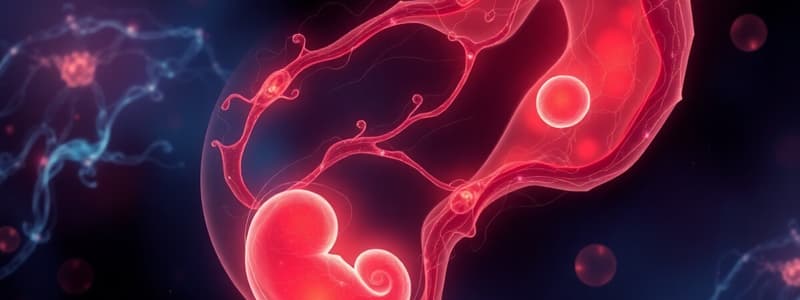Podcast
Questions and Answers
What is the primary function of placental villi?
What is the primary function of placental villi?
- To transport oxygen from the mother to the fetus
- To provide a surface area for gas and nutrient exchange between the mother and fetus (correct)
- To protect the fetus from the mother's immune system
- To produce hormones that regulate fetal development
What process occurs during the follicular phase of the menstrual cycle that prepares the uterus for implantation?
What process occurs during the follicular phase of the menstrual cycle that prepares the uterus for implantation?
- Proliferation of the endometrial layer and increased vascularization (correct)
- Formation of the placenta
- Secretion of nutrients from uterine glands
- Release of an ovum from the ovary
Where does fertilization typically occur?
Where does fertilization typically occur?
- In the uterus
- In the fallopian tubes (correct)
- In the ovary
- In the cervix
What is the role of progesterone during the luteal phase?
What is the role of progesterone during the luteal phase?
How do waste products from the fetus get removed?
How do waste products from the fetus get removed?
What is the decidua?
What is the decidua?
What is the primary source of nutrients for the developing embryo during the early stages of pregnancy?
What is the primary source of nutrients for the developing embryo during the early stages of pregnancy?
Which of the following hormones is NOT primarily involved in the changes that occur in the uterus during pregnancy?
Which of the following hormones is NOT primarily involved in the changes that occur in the uterus during pregnancy?
Which of the following hormones is directly responsible for milk ejection?
Which of the following hormones is directly responsible for milk ejection?
What is the role of the fetal adrenal gland in labor initiation?
What is the role of the fetal adrenal gland in labor initiation?
Which hormone is responsible for maintaining the corpus luteum during early pregnancy?
Which hormone is responsible for maintaining the corpus luteum during early pregnancy?
Which of the following is NOT a physiological effect of estrogen during mid-late pregnancy?
Which of the following is NOT a physiological effect of estrogen during mid-late pregnancy?
What is the primary reason why lactation is not a reliable method of birth control?
What is the primary reason why lactation is not a reliable method of birth control?
What is the main effect of cortisol and DHEA produced by the fetal adrenal gland at the end of gestation?
What is the main effect of cortisol and DHEA produced by the fetal adrenal gland at the end of gestation?
How do changes in progesterone receptors in the myometrium contribute to labor initiation?
How do changes in progesterone receptors in the myometrium contribute to labor initiation?
What is the role of the placenta in converting DHEA to estrogen?
What is the role of the placenta in converting DHEA to estrogen?
What is the primary role of progesterone in maintaining pregnancy?
What is the primary role of progesterone in maintaining pregnancy?
Which hormone is responsible for the development of mammary ducts during puberty?
Which hormone is responsible for the development of mammary ducts during puberty?
What is the primary function of hCG (Human Chorionic Gonadotropin) during early pregnancy?
What is the primary function of hCG (Human Chorionic Gonadotropin) during early pregnancy?
What is the primary cause of the increase in blood volume during pregnancy?
What is the primary cause of the increase in blood volume during pregnancy?
Which of the following is NOT a consequence of increased estrogen levels during labor?
Which of the following is NOT a consequence of increased estrogen levels during labor?
Which of the following hormones contributes to increased insulin resistance during pregnancy?
Which of the following hormones contributes to increased insulin resistance during pregnancy?
What is the primary physiological change that causes the decrease in blood pressure during normal pregnancy?
What is the primary physiological change that causes the decrease in blood pressure during normal pregnancy?
What is the role of prostaglandin PGF2 alpha in labor?
What is the role of prostaglandin PGF2 alpha in labor?
Why does milk production not start until after birth?
Why does milk production not start until after birth?
What triggers oxytocin secretion during labor?
What triggers oxytocin secretion during labor?
Which of the following hormones is directly involved in the coordinated contractions of the myometrium during labor?
Which of the following hormones is directly involved in the coordinated contractions of the myometrium during labor?
Which of the following is NOT a function of trophoblast cells?
Which of the following is NOT a function of trophoblast cells?
What is the primary function of placental lactogen during pregnancy?
What is the primary function of placental lactogen during pregnancy?
What happens to the brain-pituitary-gonadal axis during pregnancy?
What happens to the brain-pituitary-gonadal axis during pregnancy?
How does the placenta contribute to increased estrogen levels during labor?
How does the placenta contribute to increased estrogen levels during labor?
Flashcards
Luteal Phase
Luteal Phase
The phase after ovulation during which fertilization and early embryo development occur.
Endometrial Proliferation
Endometrial Proliferation
Increase in thickness and vascularization of the uterine lining prior to implantation.
Placenta
Placenta
A structure formed from fetal tissues that provides nutrient and gas exchange between mother and fetus.
Implantation
Implantation
Signup and view all the flashcards
Placental Villi
Placental Villi
Signup and view all the flashcards
Trophoblast Cells
Trophoblast Cells
Signup and view all the flashcards
Nutrient Exchange
Nutrient Exchange
Signup and view all the flashcards
Hormonal Changes in Pregnancy
Hormonal Changes in Pregnancy
Signup and view all the flashcards
Fetal Role in Birth Timing
Fetal Role in Birth Timing
Signup and view all the flashcards
Estriol
Estriol
Signup and view all the flashcards
Progesterone Response in Labor
Progesterone Response in Labor
Signup and view all the flashcards
Role of Prolactin in Lactation
Role of Prolactin in Lactation
Signup and view all the flashcards
Oxytocin in Milk Ejection
Oxytocin in Milk Ejection
Signup and view all the flashcards
Colostrum
Colostrum
Signup and view all the flashcards
hCG Role in Early Pregnancy
hCG Role in Early Pregnancy
Signup and view all the flashcards
Labor Initiation Factors
Labor Initiation Factors
Signup and view all the flashcards
Myometrium
Myometrium
Signup and view all the flashcards
Estrogen
Estrogen
Signup and view all the flashcards
Progesterone
Progesterone
Signup and view all the flashcards
Human Chorionic Gonadotropin (hCG)
Human Chorionic Gonadotropin (hCG)
Signup and view all the flashcards
Placental Shift
Placental Shift
Signup and view all the flashcards
Placental Lactogen (hPL)
Placental Lactogen (hPL)
Signup and view all the flashcards
Brain-Pituitary-Gonadal Axis
Brain-Pituitary-Gonadal Axis
Signup and view all the flashcards
Cardiac Output Increase
Cardiac Output Increase
Signup and view all the flashcards
Gestational Hypertension
Gestational Hypertension
Signup and view all the flashcards
Insulin Resistance
Insulin Resistance
Signup and view all the flashcards
Labor Initiation
Labor Initiation
Signup and view all the flashcards
Positive Feedback Loop
Positive Feedback Loop
Signup and view all the flashcards
Estrogen and Progesterone Balance
Estrogen and Progesterone Balance
Signup and view all the flashcards
Decidua
Decidua
Signup and view all the flashcards
Study Notes
Female Pregnancy Overview
- Pregnancy involves complex hormonal and physiological changes throughout various stages.
- Key hormones like hCG, estrogen, progesterone, and placental lactogen (hPL) play crucial roles throughout pregnancy, affecting uterine structure, blood flow, metabolic shifts, and lactation.
- Fetal adrenal hormones like DHEA and cortisol are vital for the timing of labor.
Early Pregnancy (Luteal Phase)
- Fertilization occurs in the fallopian tubes early in the luteal phase.
- Progesterone secreted during this phase promotes nutrient secretion for embryo nourishment.
- Implantation of the embryo into the uterine wall occurs around day seven.
- The uterine wall, the decidua, develops around the embryo, ultimately becoming the placenta. This placental tissue includes villi and trophoblast cells.
Placenta Structure and Function
- The placenta facilitates nutrient exchange between mother and fetus.
- Fetal capillaries and maternal blood in the placental villi facilitate oxygen, nutrient, and waste exchange crucial for fetal development.
- Trophoblast cells within the placenta act as transporters and regulators of substances, supporting metabolic processes essential for the fetus.
Uterine Changes
- Estrogen and progesterone influence the uterine wall throughout pregnancy.
- Estrogen promotes proliferation of the endometrium, increasing uterine thickness.
- Progesterone decreases uterine contractility, maintaining uterine quiescence.
- The uterine muscular layer (myometrium) also undergoes proliferation, essential for labor. Increased vascular growth enhances blood flow to the placenta.
Key Placental Hormones
- hCG: A hormone crucial for early pregnancy, stimulating the corpus luteum to produce estrogen and progesterone. Low levels can lead to pregnancy loss.
- Placental Shift: Around weeks 8-12, the placenta begins producing its own estrogen and progesterone, taking over from the corpus luteum.
- hPL: Similar to prolactin and growth hormone, impacting breast development and glucose metabolism.
Physiological Changes During Pregnancy
- Brain-Pituitary-Gonadal Axis: Estrogen and progesterone from the placenta inhibit LH and FSH, preventing ovulation. Progesterone elevates body temperature.
- Food Intake: Increased hunger and metabolic demand are common.
- Mammary Gland Changes: Ductal growth occurs at puberty, and lobular-alveolar growth starts during the first trimester, stimulated by hormones.
- Cardiovascular System: Increased blood volume (about 40%), cardiac output, and uterine blood flow. Despite increased volume, blood pressure tends to decrease during normal pregnancy. Gestational hypertension is an abnormal increase.
- Metabolic Changes: Elevated glucose (due to insulin resistance), higher insulin levels, and fat deposition support fetal development. Gestational diabetes can result from excessive insulin resistance.
Labor and Delivery
- Estrogen's Role: Stimulates myometrial contractions, impacting oxytocin and prostaglandin effectiveness.
- Prostaglandin PGF2 alpha: Another hormone contributing to uterine contractions.
- Oxytocin's Role: Uterine contractions trigger oxytocin release, creating a positive feedback loop until delivery.
Control of Parturition (Birth)
- Estrogen/Progesterone Balance: The shift towards higher estrogen levels initiates labor.
- Fetal Role: Fetal adrenal hormones (particularly DHEA) contribute to increasing maternal estrogen levels, ultimately triggering labor.
Lactation
- Suckling: Stimulates prolactin and oxytocin release, essential for milk production and ejection.
- Prolactin: Increases milk protein production.
- Oxytocin: Ejects milk via myoepithelial cells.
- Colostrum: Early milk is lower in protein but rich in antibodies and glucose.
Pregnancy Summary
- Each stage of pregnancy (early, mid-late) involves unique sets of hormones, physiological changes, and associated functions.
- The placenta is a crucial interface for nutrient and gas exchange and hormone production.
- Labor and delivery are initiated and regulated by an intricate balance of hormones and fetal signals.
- Lactation follows delivery, and involves a complex neuroendocrine reflex.
Studying That Suits You
Use AI to generate personalized quizzes and flashcards to suit your learning preferences.




